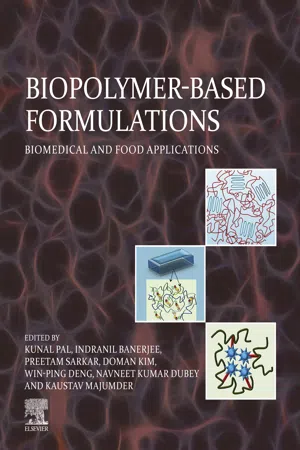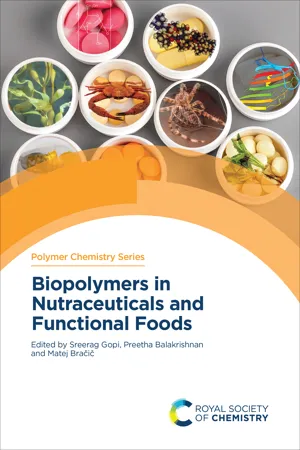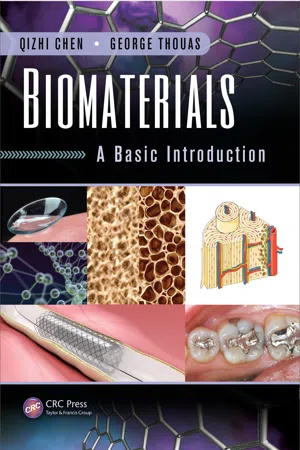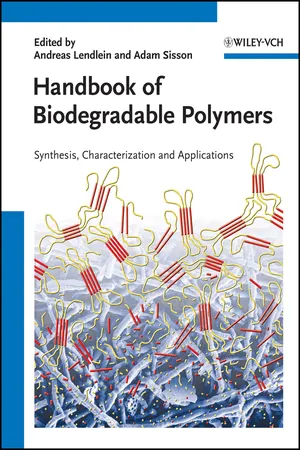Biopolymers
Biopolymers are large molecules made up of repeating units called monomers, which are found in living organisms. They include proteins, nucleic acids, and carbohydrates. In the context of physics, biopolymers are studied for their mechanical properties, such as elasticity and flexibility, as well as their behavior under various conditions, which can have applications in materials science and biophysics.
Related key terms
11 Key excerpts on "Biopolymers"
- eBook - PDF
- Johan R C van der Maarel(Author)
- 2007(Publication Date)
- WSPC(Publisher)
The biological functions of nucleic acids, proteins and polysaccharides are also different. Nucleic acids are 2 Introduction to Biopolymer Physics involved with the storage of the genetic code (DNA) and the translation of the genetic information into protein products (RNA). Proteins catalyze biochemical reactions (enzymes), have structural or mechanical functions or are important in cell signalling and immune responses. The structural components of plants are primarily composed of the polysaccharide cellulose. Bacteria excrete polysaccharides for adhesion to surfaces and to avoid dehydration. Examples of these polysaccharides are dextran, xanthan and pullulan, which have found wide-spread applications in pharmacy, biotechnology and the food industry. The classification according to the functioning of the Biopolymers is also not unique. An important exception is the ribosome; an organelle on which proteins are assembled. A ribosome contains 65% RNA and 35% protein. It can be considered an enzyme, but its active site is made of RNA. However, the functioning and purpose of Biopolymers in the machinery of life is beyond the scope of this book. Here, we intend to explore the extent to which their properties can be understood in terms of concepts from physics and mathematics. Like every polymer, Biopolymers are strings or sequences of monomeric units or monomers for short. In many cases these strings are linear, but sometimes they are closed and circular, branched or even cross-linked. In the latter case, we are dealing with a gel. In this book, we will primarily focus on linear polymers, but we will also discuss star-branched polymers, spherical polymer brushes and closed circular, supercoiled DNA. The structure of any biopolymer is determined by the nature of the building blocks ( i.e . the monomeric units) in combination with environmental conditions such as the temperature, the solvent (water) and the presence of salts and/or other molecular components. - eBook - ePub
Biopolymer-Based Formulations
Biomedical and Food Applications
- Kunal Pal, Indranil Banerjee, Preetam Sarkar, Doman Kim, Win-Ping Deng, Navneet Kumar Dubey, Kaustav Majumder, Kunal Pal, Indranil Banerjee, Preetam Sarkar, Doman Kim, Win-Ping Deng, Navneet Kumar Dubey, Kaustav Majumder, Dr. Kunal Pal(Authors)
- 2020(Publication Date)
- Elsevier(Publisher)
Biopolymers are also called as natural polymers as they are synthesized during the growth of living organism (Vijayendra and Shamala, 2013). Some examples of Biopolymers are proteins, carbohydrates, DNA, RNA, lipids, nucleic acids, peptides, and polysaccharides (such as glycogen, starch, and cellulose). Biopolymers can be broadly classified as natural and synthetic Biopolymers. Synthetic Biopolymers are of two types: nondegradable and degradable (Table 6.1). Biopolymers on the basis of monomers used and the structure of the biopolymer formed are classified into three main classes, viz. polynucleotides, polypeptides, and polysaccharides. Polynucleotides (RNA and DNA) are made up of nucleotide monomers. Polypeptides are made up of amino acids and are short polymers. Polymers of polysaccharides are carbohydrate structures and regularly bonded linear (Chandra and Rustgi, 1998 ; Kumar et al., 2007 ; Meyers et al., 2008 ; Mohanty et al., 2005). Rubber, suberin, melanin, and lignin are the few other examples of Biopolymers. The biomaterials that are made from proteins, polysaccharides, and synthetic Biopolymers do not have mechanical properties and stability in aqueous environments. These properties are required for applications in medical field. The industrial applications of polymers depend broadly on the plants or marine algae-based materials. Natural polymers possess a large variety of applications in food and pharmaceutical industries and are also being used for several industrial functions such as petroleum well drilling, explosives, photography, making shampoos, in paper industry, fire fighting, textiles, etc - Sreerag Gopi, Preetha Balakrishnan, Matej Brai, Sreerag Gopi, Preetha Balakrishnan, Matej Brai(Authors)
- 2022(Publication Date)
- Royal Society of Chemistry(Publisher)
Biopolymer materials have been extensively used for various applications, especially in pharmaceuticals, nutraceuticals, and functional foods. 113 – 115 However, it is imperative that the environment is preserved during their manufacture in addition to ensuring that they are safe to consume. Biopolymers are mainly classified based on three major categories: (a) nucleic acids, (b) proteins, and (c) polysaccharides, as shown in Figure 1.13. Polysaccharides are the main naturally occurring polymers, with the large carbohydrate family, primarily found in the form of starch, cellulose, and alginate. Interestingly, this classification of Biopolymers has important exceptions. For example, glycoproteins are a combination of two major Biopolymers, proteins and polysaccharides (glycans), that have recognition functions in immune cells and tissue adhesion. Figure 1.13 Schematic diagram of three significant sources of Biopolymers. In addition, nucleic acids, proteins, and polysaccharides all have different biological functions. Nucleic acids are constituents of living organisms involved in cell division and growth, especially in the form of DNA and RNA. Meanwhile, the human gastrointestinal tract (GIT) can easily digest proteins to release bioactive components. 116, 117 In addition, proteins in the form of antioxidative enzymes can help to protect active ingredients from being oxidized in the human body. Furthermore, proteins also have outstanding functional properties such as emulsification, gelatin, foaming, and water-binding capacity, making them popular in nutraceutical delivery devices. 118, 119 Biopolymer particles made from proteins can be derived from animals and plants. Moreover, proteins can be divided into several types as follows. a) Antibodies. Antibodies are known as a family of proteins with several properties in common and they are found in the gamma globulin fraction of the blood- eBook - ePub
Biomolecular Engineering Solutions for Renewable Specialty Chemicals
Microorganisms, Products, and Processes
- R. Navanietha Krishnaraj, Rajesh K. Sani, R. Navanietha Krishnaraj, Rajesh K. Sani(Authors)
- 2021(Publication Date)
- Wiley(Publisher)
Biopolymers can be classified based on its source from which they are derived such as polysaccharides (cellulose, starch, chitin, chitosan, alginate, etc.), polypeptides (silk fibroin, elastin, collagen, gelatin, etc.), and polynucleotides (DNA, RNA). They can be plant‐based, animal‐based, or microorganism‐based biopolymer. Microscopic molecules that makes up the polymer sets as the critical factor for the functioning of its translated three‐dimensional product. Hence, it is very crucial in understanding its monomeric substituents. The common factor that binds these polymers in one pot is that these are nature‐procured materials, but microscopically these display different entities that gives them unique attributes. One tough realization here is that these being bio‐based is not sufficient to render it for direct application. They may execute varying degrees of physical, chemical, and mechanical features, which can also limit themselves from its prompt implementation. Therefore, the strategy employed here is to modulate each polymer with respect to its intended application.This chapter gives an overview of the multifarious Biopolymers and special focus onto its application in the biopharmaceutical sector under the subtopics tissue engineering, bio sensing, bio imaging, drug delivery, biological implants, wound healing, cancer therapeutics, and other industrial applications. Further, some fundamental fabrication techniques will be discussed such as 3D/4D bioprinting and electrospinning.7.2 Natures’ Advanced Materials: A Glance at Its Structure and Properties
7.2.1 Polypeptides
Short peptide motifs can be contrived into Biopolymers where some can be categorized into thermoresponsive Biopolymers such as those based on leucine zippers, human collagen, human elastin, and silkworm silk to give peptide‐based Biopolymers (Figure 7.1 ). Peptides can be either obtain in their pure form and synthesized chemically or through recombinant technology with genetic engineering tools.7.2.1.1 Collagen
Type I collagen represents 25–35% of the total protein content of our body and forms the main component of the extracellular matrix found in skin, bone, tendon, cornea, and ligament. It reveals a monomeric, triple helix configuration, composed of two identical alpha1 and 1 alpha2 chain. It comprises of the unique RGD (arginine, glycine, aspartic acid) domains, which leverage cell adhesion by recognizing cell integrin receptors (Emsley et al., 2000 ). Collagen is the most widely used bioink for fabricating tissue scaffolds due to its low antigenicity, excellent biocompatibility, low immunogenicity, and able to get degrade completely by the collagenases and hydrolytic mechanisms (Marques et al., 2019 - Vijay Kumar Thakur, Manju Kumari Thakur, Vijay Kumar Thakur, Manju Kumari Thakur(Authors)
- 2015(Publication Date)
- Wiley-Scrivener(Publisher)
Biopolymers are generally considered eco-friendly alternatives to petrochemical polymers due to their renewable feedstock and biodegradability. However, the farming practices used to grow these feedstocks carry significant environmental burdens, and the production energy can be higher than for petrochemical polymers. Biobased polymers have become feasible alternatives to traditional petroleum-based plastics. However, the factors that influence the sustainability of biobased polymers are often unclear. This chapter reviews the published life cycle assessments (LCAs) and commonly used LCA databases that quantify the environmental sustainability of biobased polymers and summarizes the range of findings reported within the literature. LCA is discussed as a means for quantifying environmental impacts for the product from its cradle, or raw materials extraction, to the grave, or end of life. The results of LCAs from existing databases as well as the peer-reviewed literature allow for the comparison of environmental impacts. Recently, interest in composite manufacturing has shifted towards the use of natural fibers as reinforcement because of their environmental benefits. The use of a biodegradable matrix is worth considering since this would result in a completely biodegradable composite. In order to assess the most suitable matrix polymer, one must know the properties of the available polymers. This chapter reviews the importance of Biopolymers in the present decade and also discusses the preparation of Biopolymers and its properties.Keywords: Biopolymer, nature, drug delivery, production, property16.1 Introduction
Biopolymers are polymers that were produced from renewable natural sources, which are biodegradable, and are not toxic. These can also be produced by biological systems (i.e., microorganisms, plants and animals) or chemically synthesized from biological starting materials (e.g., sugars, starch, natural fats, oils, etc.). These Biopolymers are an alternative source to petroleum-based polymers “traditional plastics.” The biopolyesters have properties similar to traditional polyesters. Starch-based polymers are often a blend of starch and other plastics, which allows for increased environmental properties. Biopolymers have emerged as potential alternatives, some of which are available commercially, while others remain under research. The term biopolymer refers to naturally occurring long-chain molecules but also materials which have been derived from these or biobased monomers [1]. Most of these will also be biodegradable [2]; however this is not necessarily the case. A biopolymer made from annually renewable resources which will biodegrade can appear to solve the major problems associated with plastics. The feedstock is no longer of fossil origin, thereby improving resource security [3], and at the end of its life, the polymer is capable of biodegrading to leave no waste product [4].- eBook - PDF
Biomaterials
A Basic Introduction
- Qizhi Chen, George Thouas(Authors)
- 2014(Publication Date)
- CRC Press(Publisher)
10.8 BIOLOGICAL POLYMERS As introduced in Chapter 1, biomaterials encompass biological materials. Biomacromolecules can be classified into four groups: 1. Polysaccharides (polymers with carbohydrate monomers) 2. Proteins (polymers with amino acid monomers) 3. Lipids (i.e., fatty acids = short chain hydrocarbons, with mixed saturated and unsaturated C − C bonds, sometimes with trimester cross-links) 4. Polynucleic acids (i.e., DNA, RNA—purine and pyrimdine polymers) More discussions on these biomacromolecules will be provided in the Advanced Topic section of this chapter and in Chapter 16. 10.9 CHAPTER HIGHLIGHTS 1. The biodegradation of polymers proceeds in three major steps: Cleavage → Metabolism → Excretion. 2. Cleavage is initiated by abiotic mechanisms, which include hydrolysis and/ or oxidation. The kinetics of an abiotic process is determined by the physical accessibility of the polymer structure to water or oxygen molecules. Abiotic mechanisms proceed in a diffuse manner. 3. Biodegradation rates of chemical bonds in polymers: • C − C, C − H, C − F, Si − O: physiologically inert • HN − CO, peptide bond: hydrolyzable but very slowly, virtually impossible without enzyme activity • CO − O, ester bond: hydrolysis proceeds without enzyme activity, though can be accelerated by enzyme-mediation Polymer carrier Degraded polymer Released drug Drug Figure 10.20 Controlled drug release. Bioresorbable Polymers 357 4. A rank of some polyesters, in terms of degradation kinetics, from faster to slow: PGLA PGA PDLLA PLLA PCL P3HB Degradation rate dec > > > > > reasing → which can be explained by the steric hindrance of side chains and crystallinity of these polymers. 5. The degradation product of these polyesters is their monomers, that is, glycolic acid, lactic acids, or primelic acid. These chemicals are natural metabolites in the body and can be excreted by the physiological system. - eBook - PDF
- Vania Regina Nicoletti Telis(Author)
- 2012(Publication Date)
- CRC Press(Publisher)
1 1 An Introduction to Biopolymer Applications in Food Engineering Vânia Regina Nicoletti Telis 1.1 INTRODUCTION The class of Biopolymers encompasses all the polymeric compounds produced by living organisms and are mainly represented by polysaccharides, proteins, and nucleic acids� Polysaccharides and proteins have traditionally played a major role in the food industry, presenting an extensive range of accomplished applications� Biopolymer non-food applications are also widespread and in constant development, chiefly in medi-cine—where tissue engineering strategies are focused on the development of improved supportive scaffolds and new drug delivery systems—as well as in nanotechnology� Biopolymers are natural components of most raw materials used in food produc-tion� The two major classes of food Biopolymers are proteins and polysaccharides, which can occur as pure macromolecules or as a part of specific structures with supramolecular properties� Proteins in food systems are often highly denatured by heat, pH, or shear, with much of their structural integrity destroyed, whereas polysaccharides are branched or linear polymers of sugars that in nature serve as an energy reserve or are present as hydrated networks in the exocellular and endocellular material of plant and marine organisms� Polysaccharides may also be synthesized by CONTENTS 1�1 Introduction ������������������������������������������������������������������������������������������������������ 1 1�2 Polysaccharides and Their Applications in Food Processing ��������������������������� 2 1�3 Proteins and Their Applications in Food Processing ��������������������������������������� 2 1�4 Protein–Polysaccharide Blends and Their Functionalities ������������������������������� 3 1�5 Functionality of Biopolymers in Different Food Processes and Products ������� 5 1�5�1 Biopolymer Particles and Complexes as - eBook - PDF
Introduction to Biomaterials
Basic Theory with Engineering Applications
- C. Mauli Agrawal, Joo L. Ong, Mark R. Appleford, Gopinath Mani(Authors)
- 2013(Publication Date)
- Cambridge University Press(Publisher)
6 Polymers Goals After reading this chapter the student will understand the following. Structure of polymers and their common physical states. General properties of polymers. Common types of polymerization techniques used for production. Chemical structure and properties of common biomedical polymers. Structure of hydrogels and their general properties. De fi nition and uses of nanopolymers. In everyday life, we encounter a variety of polymers, some natural and others synthetic. The vast majority of these are carbon-based in nature. They range from synthetic polymers seen in products such as polyethylene grocery bags, polymethylmethacrylate-based window panes, and polystyrene-based eating uten-sils, to natural polymers such as starch, cellulose and rubber. Polymers used as biomaterials are often similar to these common materials. For example, the polymer most extensively used in total joint prostheses is ultrahigh molecular weight polyethylene – chemically identical to the material used for plastic bags, although having a much higher molecular weight. The same is true for bone cement which is used in conjunction with bone surgery and Plexiglass ® , which is used for window panes. Both of these materials are polymethylmethacrylate (PMMA). Of course, any polymer that is used as an implant has to meet strict safety standards as required by governmental and other regulatory agencies and has to be virtually contaminant free. Polymers have the advantage that they can be easily formed into desired shapes using a variety of techniques such as solution casting, melt molding, or machining. Thus, polymer-based implants are relatively inexpensive to manufacture. Poly-mers can also be made reactive so that different chemical molecules can be attached to the surface of implants in order to make them more compatible with the surrounding environment in the body. - eBook - ePub
Renewable Resources for Functional Polymers and Biomaterials
Polysaccharides, Proteins and Polyesters
- Peter Williams(Author)
- 2015(Publication Date)
- Royal Society of Chemistry(Publisher)
CHAPTER 1 Natural Polymers: Introduction and Overview PETER A. WILLIAMS Glyndwr University, Plas Coch, Mold Road, Wrexham LL11 2AW, UKThis chapter introduces the aim and scope of the book and presents an overview of the subject of natural polymers, mainly polysaccharides and proteins, but also microbial polyesters and nucleic acids. Details of the types, names and functions of individual polysaccharides and proteins are provided together with examples of their structural and physicochemical characteristics. It also highlights the main functional properties of these polymers including their rheological behavior, mechanisms of gelation, emulsification characteristics and film formation. The main applications of polysaccharides and proteins in medical and industrial sectors are also outlined with market size and trends.
1.1 Introduction to Biopolymers
Proteins and polysaccharides are found abundantly in nature and are major constituents of plants, animals and micro-organisms serving a number of important functions.1 ,2Proteins are composed of amino acids and although there are hundreds of different proteins they all consist of linear chains of the same twenty L -α-amino acids which are linked through peptide bonds formed by a condensation reaction. Each amino acid contains an amino group and carboxylic acid group with the general formula:The R group differs for the various amino acids and can impart polar, non-polar, anionic or cationic characteristics. The amino acid units are linked together through a peptide bond to form a polypeptide chain as illustrated below:Proteins consisting of between 15 and 10 000 amino acids are known. Since proteins contain both cationic and anionic charges due to the presence of ionisable groups, notably amine and carboxyl, they have a characteristic isoelectric point which corresponds to the pH at which the molecules have a net zero charge.There are various levels of protein structure. The protein primary structure is defined by the characteristic sequence of amino acids of the polypeptide chain. Certain amino acids within the chain give rise to local secondary structures such as the α helix and the pleated sheet. There is a tendency for the more hydrophobic amino acids present to reside within the core of the molecule so that they are less exposed to the aqueous environment, and the overall shape of the protein that is formed (the tertiary structure) is stabilised by a range of interactions including hydrogen bonds, disulfide bonds and salt bridges. The protein molecules may self-associate to create a larger assembly referred to as quaternary structures.Proteins tend to have either a linear or globular conformation and have a unique characteristic molecular mass. Linear proteins function as structural elements in the connective tissue of animals. The polypeptide chains are arranged in parallel forming long fibres. Fibrous proteins are insoluble in aqueous environments and are mechanically strong. Examples include collagen, found in tendons, cartilage and bone, and keratin, found in hair, skin and nails. Other proteins tend to fold into compact spherical or globular conformations. Globular proteins tend to be soluble in aqueous environments and are involved in transport processes or in dynamic functions in the cell. There are also special classes of proteins such as enzymes which are able to selectively cleave covalent bonds in biomacromolecules and antibodies which can attach to specific binding sites. Table 1.1 - eBook - PDF
- Carol Lin, Rafael Luque(Authors)
- 2014(Publication Date)
- Royal Society of Chemistry(Publisher)
CHAPTER 1 Bio-based Polymers and Materials NATHALIE BEREZINA* a AND SILVIA MARIA MARTELLI b a Materia Nova, Rue des Foudriers 1, 7822 Ghislenghien, Belgium; b Faculty of Engineering, Federal University of Grande Dourados, Dourados, Brazil *Email: [email protected] 1.1 Introduction Biomaterials have gained attractiveness in the last decades due to both ecological and economic concerns. Increased pollution, and especially visible pollution, has first driven the scientific and industrial communities to look at biofragmentable and biodegradable substitutes for traditional petroleum-based non-biodegradable materials. Then the dramatic increase of oil prices before the economic crisis of 2007 influenced the move from the biodegradable to the bio-based. Finally, the compliance of the obtained materials with thermo-mechanical constraints has turned interest to the partially bio-based materials. Bio-based materials can be obtained mainly by two different ways: the direct production of polymers or the production of bio-based monomers and their further (bio)chemical polymerization. The direct production of bio-polymers can be achieved by microorganisms (polyhydroxyalkanoates, PHA), by algae (alginate etc. ), by superior plants (pectin etc. ) or by several types of producers, e.g. cellulose is produced by superior plants but also by bacteria, chitosan is produced by crustacean but also by fungi. RSC Green Chemistry No. 27 Renewable Resources for Biorefineries Edited by Carol Sze Ki Lin and Rafael Luque r The Royal Society of Chemistry 2014 Published by the Royal Society of Chemistry, www.rsc.org 1 Whatever the producer of Biopolymers, the main difficulty is to trigger its composition. Indeed, the obtained material has to comply with the thermo-mechanical constraints of its anticipated usages, and these characteristics are strongly related to the monomeric composition of the polymer and its size. This common problem of Biopolymers does not have a unique solution. - eBook - ePub
Handbook of Biodegradable Polymers
Isolation, Synthesis, Characterization and Applications
- Andreas Lendlein, Adam Sisson(Authors)
- 2011(Publication Date)
- Wiley-VCH(Publisher)
5 Biodegradable Polymers Composed of Naturally Occurring α-Amino Acids Ramaz Katsarava and Zaza Gomurashvili5.1 IntroductionThe synthesis and study of biodegradable polymers is at the forefront of modern polymer chemistry because of the technological challenge and commercial potential. For many medical, agricultural, and environmental purposes, it is important to have biodegradable polymers that degrade under the action of physiological environment or in soil. Biodegradable polymers have become increasingly important for the development of surgical and pharmaceutical devices like wound closure devices, vascular grafts, nerve guidance tubes, absorbable bone plates, orthopedic pins and screws, body-wall/hernia repair, sustained/controlled drug delivery systems, to name a few. Different materials with tailored properties are required for each of these applications. Therefore, biodegradable polymers with a variety of hydrophilicity/hydrophobicity, permeability, morphology, degradation rates, chemical, and mechanical properties are needed.The limitation for many synthetic biodegradable polymers as biomedical materials is the potential toxicity of the degradation products. Therefore, research was focused toward the materials entirely composed of naturally occurring and nontoxic (“physiological”) building blocks. Such polymers release metabolic components upon biodegradation, which are digested by cells and reveal certain nutritious values, in parallel with high biocompatibility.In the light of this, heterochain polymers composed of α-hydroxy acids (α-HAs) and α-amino acids (α-AAs) are considered as promising representatives of synthetic resorbable biomaterials, especially the latter because after biodegradation the release products are essential α-AAs and their derivatives.Well-characterized aliphatic polyesters (PEs), for example, PGA, PLA, PLGA, PDLLA [1], are far from perfect: the synthesis of PEs requires dry conditions, which is rather complex and costly. The shelf-life of the PEs is rather short. Also, aliphatic PEs reveal useful material properties only at high molecular weights (100,000 Da and higher) due to weak intermolecular forces. They show low hydrophilicity and hence do not actively interact with the surrounding tissues in a desirable manner after implantation that diminishes the biocompatibility [2].










